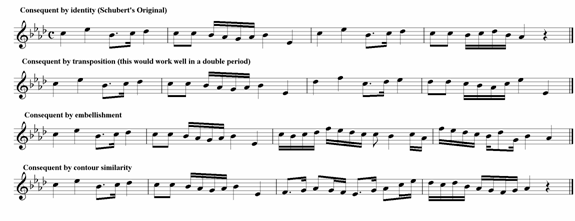Periods
Click here for Scott Foglesong's audio lecture on basic period structures.
Definition: two phrases, called antecedent and consequent
- Play antecedent only
- Play consequent only
- Play entire phrase (or click on the example)

Antecedent: interrogative in character, generally terminated by a non-final cadence.
This cadence is usually a half-cadence of some sort.
- Play antecedent only
- Play entire phrase (or click on the example)

Sometimes the cadence is an authentic cadence
Rhythmically weak ending to the antecedent
- Play antecedent only
- Play entire phrase (or click on the example)

Leads into a modulating consequent (click the example to play it)

If the period is Part II of a 3-part song form, it may well end in a half-cadence (leading into Part III which will almost certainly be in the tonic.)
- Play Part II only
- Play the entire 3-part song form (or click the example)

In a double period, the consequent usually ends in a half-cadence. (We’ll cover double periods in Unit 06.)
Consequent: responsive, usually closing with an authentic cadence
Original key: see above for examples
The tonic of a new key after a modulation (click the example to play it)

Parallel Period
The first measure (at least) of the consequent is similar to the corresponding part of the antecedent. All of the above examples are parallel periods.
Four techniques for deriving the consequent from the antecedent:
- By identity: at least the first measures (or even more) are identical
- By transposition: the consequent is a transposed version of the antecedent
- By embellishment: the consequent begins in a similar manner to the antecedent, but is ornamented and figured
- By contour similarity: the consequent is a somewhat modified sequence or a modified repetition; the outlin of the antecedent is freely followed in the consequent.
In the following four examples, Schubert’s Wiegenlied is completed in each of the four above ways. (Click each of the examples to play them.) You may play the antecedent alone by clicking here.
NOTE: due to the slow tempo, the antecedent is measures 1 - 2; the consequent is measures 3 - 4.

Contrasting Period
The direction of the melodic line in the consequent is different from that in the antecedent. (Click the example to play it.)

The rhythm of the consequent may be similar or even identical (Click the example to play it.)

It is not always perfectly clear whether a period is contrasting or not. See the Mozart C Major Piano Concerto K. 467 II: 23-29. Is this a parallel period (with contour similarity) or a contrasting period? The overall melodic motion is the same, and the consequent is sequential but rhythmically different. (I think this is a parallel period with contour similarity.) (Click the example to play it.)
